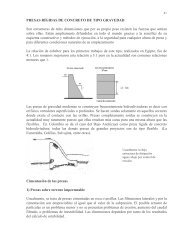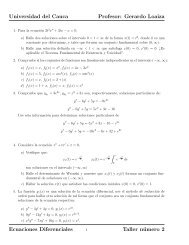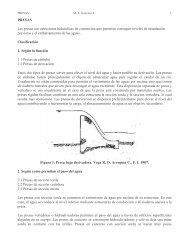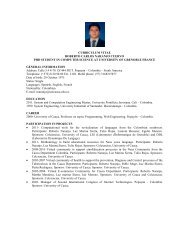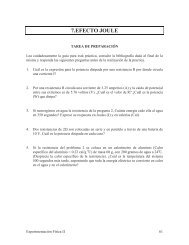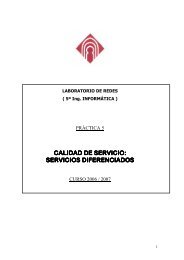Advice for the Project Management Professional (PMP)
Advice for the Project Management Professional (PMP)
Advice for the Project Management Professional (PMP)
Create successful ePaper yourself
Turn your PDF publications into a flip-book with our unique Google optimized e-Paper software.
Licensed to:<br />
426<br />
Appendix C<br />
2. Prepare a stakeholder analysis <strong>for</strong> <strong>the</strong> project. Include all project team members<br />
and make up names and in<strong>for</strong>mation <strong>for</strong> at least one spouse, one potential<br />
financial backer, and one local competitor. Assume that you and your<br />
three friends are all team members, and you each invest $10,000 into <strong>the</strong><br />
business. Your mo<strong>the</strong>r, a retired business professor, has decided to provide<br />
a substantial loan ($30,000), so she will be <strong>the</strong> sponsor. You still need to figure<br />
out how to get an additonal $30,000 <strong>for</strong> <strong>the</strong> first-year start-up costs. Use <strong>the</strong><br />
template provided on <strong>the</strong> companion Web site, and review <strong>the</strong> sample stakeholder<br />
analysis in <strong>the</strong> text.<br />
3. Prepare a team contract <strong>for</strong> this project. Use <strong>the</strong> template provided on <strong>the</strong> companion<br />
Web site, and review <strong>the</strong> sample in <strong>the</strong> text.<br />
4. Prepare a project charter <strong>for</strong> <strong>the</strong> New Business Venture <strong>Project</strong>. Assume <strong>the</strong><br />
project will take one year to complete and cost about $100,000. Recall that <strong>the</strong><br />
main project objectives are to prepare a business plan, get financial backing,<br />
handle legal issues, develop marketing materials, find a rental place <strong>for</strong> <strong>the</strong><br />
music academy, purchase/develop curriculum, hire staff, and open <strong>for</strong> business<br />
by one year from now. Your project team will not get paid <strong>for</strong> <strong>the</strong> hours<br />
<strong>the</strong>y put into this project, but once <strong>the</strong> business opens, <strong>the</strong>y will be<br />
compensated. You will incorporate <strong>the</strong> business and hire a lawyer to help with<br />
this and o<strong>the</strong>r legal issues. Use <strong>the</strong> template provided on <strong>the</strong> companion Web<br />
site, and review <strong>the</strong> sample in <strong>the</strong> text.<br />
5. An important part of starting any business is preparing financial projections.<br />
Although you will prepare a more detailed financial analysis when you create your<br />
business plan, you still want to do rough projections at this stage. Prepare a<br />
spreadsheet that can be used to determine <strong>the</strong> profit potential of starting this<br />
business. Include inputs <strong>for</strong> <strong>the</strong> initial investment cost, number of customers<br />
in <strong>the</strong> first month, customer growth rate/quarter, average monthly fee per customer,<br />
fixed and variable monthly operating costs, and variable costs per<br />
customer. Use <strong>the</strong> most likely, optimistic, and pessimistic inputs as shown in<br />
Figure C-1 to generate results <strong>for</strong> all three scenarios. For each month<br />
(Month 1-24), calculate your revenues (number of customers that month X<br />
monthly fee/customer) and expenses (fixed monthly salaries plus fixed monthly<br />
operative costs plus variable costs/customer/month X number of customers that<br />
month). Then determine <strong>the</strong> cumulative income each month. For example, <strong>the</strong><br />
cumulative income in Month 1 is <strong>the</strong> Monthly Revenues - Monthly Expenses <strong>for</strong><br />
Month 1. The cumulative income <strong>for</strong> Month 2 is <strong>the</strong> Monthly Revenues - Monthly<br />
Expenses <strong>for</strong> Month 2 plus <strong>the</strong> Cumulative Income <strong>for</strong> Month 1. The first few<br />
months <strong>for</strong> <strong>the</strong> most likely scenario are filled in <strong>for</strong> you to check your <strong>for</strong>mulas.<br />
Will you be able to recoup your $100,000 start-up costs within two years in each<br />
scenario? If so, in what month? There is no template <strong>for</strong> this example, but you can<br />
use <strong>the</strong> <strong>for</strong>mat in Figure C-1. Print out a sheet with results <strong>for</strong> each scenario,<br />
clearly labeling if/when you recoup your investment.<br />
Copyright 2009 Cengage Learning. All Rights Reserved.<br />
May not be copied, scanned, or duplicated, in whole or in part.



